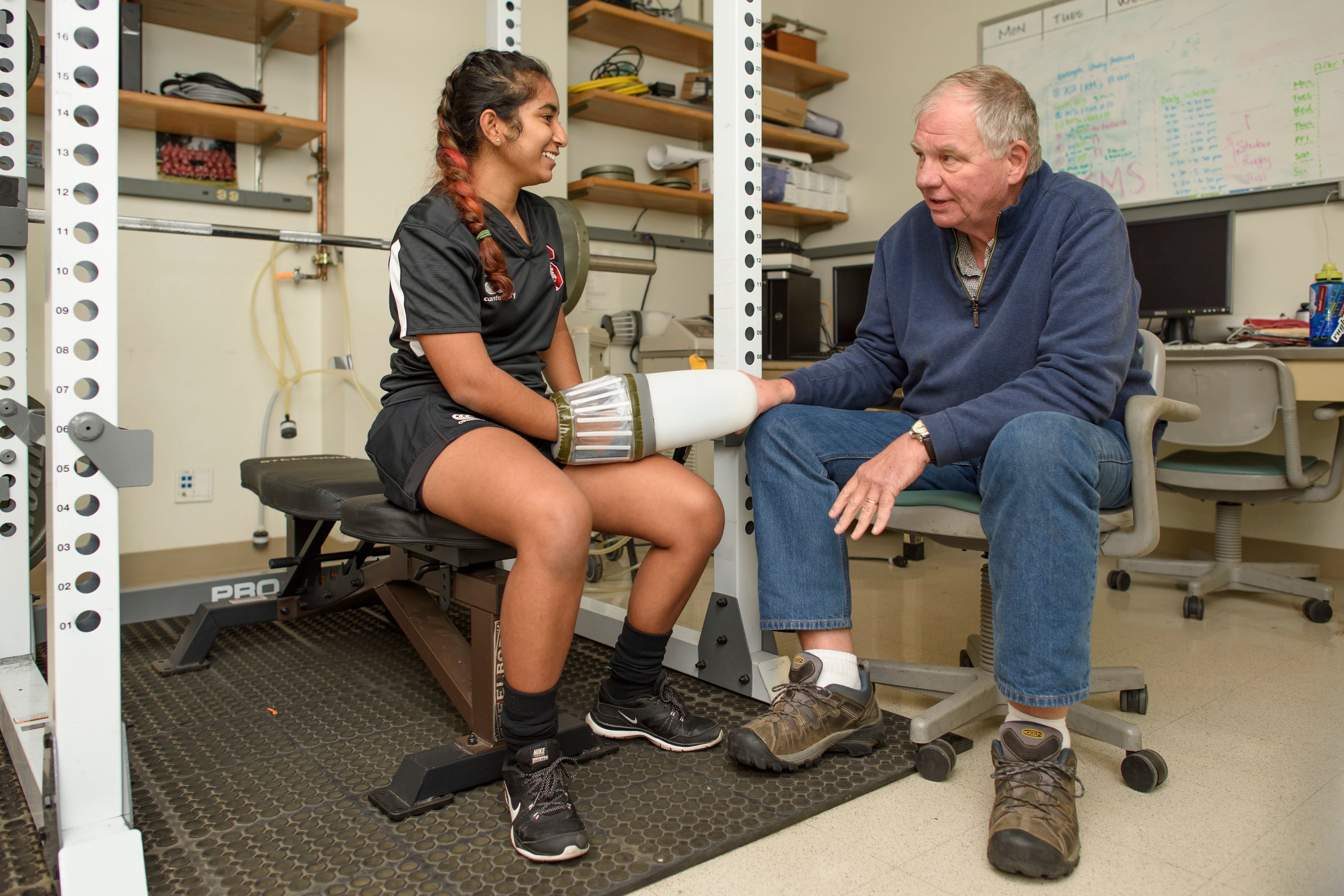Cooling glove developed by Stanford researchers helps athletes and patients
What unites the needs of Ebola workers, people with multiple sclerosis and athletes comes down to one thing – cold hands. A device that cools the hands is finding widespread use from the playing field to the clinic.
A cooling device that has been improving strength and endurance in mostly male athletes for 15 years is finding new uses in helping people with multiple sclerosis live normal lives, preventing overheating in Ebola workers and cooling working dogs. In a recent trial in women, it helped frosh participants perform hundreds of pushups in an hour.

Senior research scientist Dennis Grahn meets with student research assistant Riasoya Jodah, a Women’s Rugby team member. Jodah has been working with Heller and Grahn to test the effects of the cooling glove on strength conditioning training. (Image credit: L.A. Cicero)
The idea itself isn’t new. The mitten-like device is designed and built to draw heat out of the body’s core and has been shown to radically improve both strength and endurance. Now, Craig Heller, a professor of biology; Dennis Grahn, a senior research scientist in biology; and their lab are testing it in a variety of new settings and verifying that it is as effective in women as in men.
“One of the suggestions that always comes up is that it works on males because of the hormonal background,” Heller said, and that it might not have the same dramatic effects on women – but that suggestion appears to be wrong.
“We’ve actually had some freshmen women doing over 800 pushups” in less than an hour, Heller said.
The basic idea, Heller said, is to run cool water through a sort of mitten covering a person’s palms. The non-hairy skin of palms, soles and the face contain special blood vessels that can carry a high volume of blood to those surfaces to facilitate heat loss to the environment, Heller said.
Warming patients
Heller, who is also a member of Stanford Bio-X, said none of that would have happened had it not been for a physician friend challenging his lab with the opposite problem – rewarming patients after surgery, which can reduce body temperatures sometimes by as much as 1 or 2 degrees Celsius. Twenty years ago, no one had a particularly good, fast way to restore that lost heat.
Heller and Grahn, who worked on mammalian temperature regulation, came up with a simple device to rewarm patients: an airtight sleeve fitted over the arm, a water perfused pad in the sleeve, and a vacuum pump to create a negative pressure in the sleeve to increase blood flow in the arm. The idea was to draw blood out of a person’s core – the critical organs that actually need warming – into the arm where the blood was warmed before flowing back into the core.
The idea worked, and soon the researchers understood why. “We discovered it had nothing to do with the arm. It was only the hand,” Heller says, where special blood vessels bypass high-resistance capillaries and directly deliver blood into low-resistance veins that are arranged in a large network.
“These special blood vessels are found in the non-hairy skin. We are mammals. Most mammals have fur, so they can only dissipate heat from their non-hairy skin. We don’t have fur, but we have inherited the same specialized heat loss blood vessels,” Heller said. In essence, the non-hairy skin of the palms of our hands, soles of our feet and the upper part of our face (where we blush) are natural radiators that cool the body.
Cooling gloves heat up
Heller and team parlayed that discovery into a cooling glove that they found could keep a person’s muscles and core from overheating and, in the process, improve athletic performance. Early tests with a gym-frequenting research assistant, Vinh Cao, showed that cooling his palms in between sets increased the total number of pullups he could do in a single workout from 10 sets with 30-minute rests between to more than 600.
Subsequent tests showed the cooling method also improved endurance during cardiovascular exercise and had lasting effects on strength and endurance, but all of that early testing was in men. The cooling glove is used by Stanford athletic teams and many professional athletic teams in the United States and elsewhere in the world.
Now the group is verifying their assumption that the glove will work as well in women athletes as men by testing it in women Stanford students and staff. The participants are doing a variety of exercises and testing to see if the cooling device improves performance and recovery. So far the answer appears to be yes.
They are also exploring the device’s use in cooling overheated athletes and branching out beyond athletics to a backpack-sized system for working dogs – a project funded by the U.S. Navy – and for medical uses.
“We first got motivated to do that by some communications from Ebola workers in Sierra Leone,” Heller said, where hot temperatures and protective equipment combined to make overheating a serious problem.
Wearable cooling devices could also help patients with multiple sclerosis, who suffer symptom exacerbation when experiencing high environmental or body temperatures. Some MS patients using the current version of the technology have been able to leave their air-conditioned homes in summer and return to playing golf and engaging in other activities in spite of warm weather.
Heller is the Lorry I. Lokey/Business Wire Professor and a member of the Stanford Cardiovascular Institute and the Stanford Neurosciences Institute.
